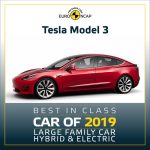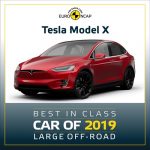
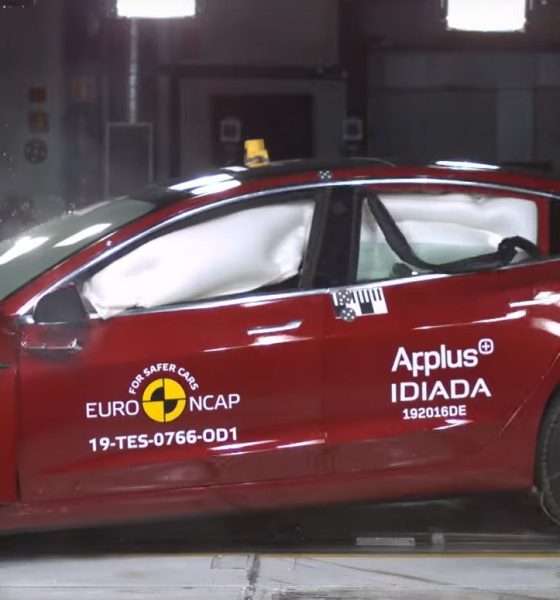
News
Tesla Model 3, Model X take top honors in Euro NCAP Best in Class Cars 2019 List
The European New Car Assessment Programme or more popularly known as Euro NCAP published its “Best of the Best of 2019” list and the Tesla Model X and Model 3 are among the Best In Class for 2019.
The Tesla Model 3 was named the best vehicle in the Large Family Car category and shared the spotlight with the BMW 3 Series, despite edging out the Bavarian sedan in Safety Assist by receiving a score of 94 versus BMW’s 76. Euro NCAP also awarded the Tesla Model X all-electric SUV as the best Large Off-Road vehicle, beating out the SEAT Tarraco which took home second place.
The awards come with prestige as Euro NCAP is one of the most respected car safety watchdogs, providing consumers with an independent and realistic safety assessment of some of Europe’s most popular vehicles. Established in 1997 and modeled after the car assessment program of the U.S. National Highway Traffic Safety Administration, the program has since served as a catalyst when it comes to improving vehicle safety. The Euro NCAP overall safety rating was introduced in 2009 and evaluates the safety of the vehicle based on four areas: Adult Occupant Protection, Child Occupant Protection, Pedestrian Protection, and Safety Assist.
The Euro NCAP safety tests simulate possible real-life accidents that may cause serious injuries or even death of vehicle occupants. For example, the frontal impact test simulates accidents such as head-on collisions where the vehicle’s structure, how its parts safely absorb different crash forces, and whether the vehicle’s design leaves enough space in the passenger compartment during big collisions are looked into because these factors can spell the difference between life and death. Euro NCAP also tests vehicles to see if their child restraint systems are properly designed and can keep the child safe during vehicular accidents.
The category on Vulnerable Road User tests how other users such as pedestrians and cyclists are at risk of injuries when they are hit by the vehicles undergoing testing. The safety watchdog also scores driver-assist technologies that help lower the risk of accidents on the road and also mitigate injuries.
As the Model 3 and Model X rule their respective categories in the Best In Class of 2019 list just helps prove that Tesla is on the right path in building safe vehicles from the ground up, plus developing technologies such as its Autopilot and Full Self-Driving features that push vehicle safety to the next level.
To be included in Euro NCAP Best in Class Cars Of 2019 list is a feather in any automotive manufacturer’s cap. It means the vehicles are among the safest on the road today.
In mid-2019, the car safety watchdog awarded the Tesla Model 3 sedan 5 stars in all of its safety categories, which set the bar higher for vehicles in its class.
“Tesla has done a great job of playing the structural benefits of an electric vehicle to its advantage. The Tesla Model 3 achieved one of the highest Safety Assist scores we have seen to date,” said Thatcham Research head of research Matthew Avery.
The Model 3 has shown off its safety features in the real world, most recently protecting a driver after an SUV landed on top of a Model 3 during a multi-car pile-up in China.
The Model 3’s bigger sibling, the Model X, is also considered a champ by Euro NCAP as it awarded Tesla’s flagship SUV a 5-Star Safety Rating in December.
Other Best In Class for 2019 winners include Mercedes-Benz CLA for the Small Family Car category with Mazda 3 as its runner-up. The Subaru Forester ruled the Small Off-Road/MPV category with the Volkswagen T-Cross and the Mazda CX-30 sharing the second spot. The best in the Supermini category was given to the Audi A1 and Renault Clio with the Ford Puma given the runner-up honors.
Check out the video footage below showing Euro NCAP’s Best In Class Cars of 2019:

Elon Musk
SpaceX Starship Version 3 booster crumples in early testing
Photos of the incident’s aftermath suggest that Booster 18 will likely be retired.

SpaceX’s new Starship first-stage booster, Booster 18, suffered major damage early Friday during its first round of testing in Starbase, Texas, just one day after rolling out of the factory.
Based on videos of the incident, the lower section of the rocket booster appeared to crumple during a pressurization test. Photos of the incident’s aftermath suggest that Booster 18 will likely be retired.
Booster test failure
SpaceX began structural and propellant-system verification tests on Booster 18 Thursday night at the Massey’s Test Site, only a few miles from Starbase’s production facilities, as noted in an Ars Technica report. At 4:04 a.m. CT on Friday, a livestream from LabPadre Space captured the booster’s lower half experiencing a sudden destructive event around its liquid oxygen tank section. Post-incident images, shared on X by @StarshipGazer, showed notable deformation in the booster’s lower structure.
Neither SpaceX nor Elon Musk had commented as of Friday morning, but the vehicle’s condition suggests it is likely a complete loss. This is quite unfortunate, as Booster 18 is already part of the Starship V3 program, which includes design fixes and upgrades intended to improve reliability. While SpaceX maintains a rather rapid Starship production line in Starbase, Booster 18 was generally expected to validate the improvements implemented in the V3 program.
Tight deadlines
SpaceX needs Starship boosters and upper stages to begin demonstrating rapid reuse, tower catches, and early operational Starlink missions over the next two years. More critically, NASA’s Artemis program depends on an on-orbit refueling test in the second half of 2026, a requirement for the vehicle’s expected crewed lunar landing around 2028.
While SpaceX is known for diagnosing failures quickly and returning to testing at unmatched speed, losing the newest-generation booster at the very start of its campaign highlights the immense challenge involved in scaling Starship into a reliable, high-cadence launch system. SpaceX, however, is known for getting things done quickly, so it would not be a surprise if the company manages to figure out what happened to Booster 18 in the near future.
News
Tesla FSD (Supervised) is about to go on “widespread” release
In a comment last October, Elon Musk stated that FSD V14.2 is “for widespread use.”

Tesla has begun rolling out Full Self-Driving (Supervised) V14.2, and with this, the wide release of the system could very well begin.
The update introduces a new high-resolution vision encoder, expanded emergency-vehicle handling, smarter routing, new parking options, and more refined driving behavior, among other improvements.
FSD V14.2 improvements
FSD (Supervised) V14.2’s release notes highlight a fully upgraded neural-network vision encoder capable of reading higher-resolution features, giving the system improved awareness of emergency vehicles, road obstacles, and even human gestures. Tesla also expanded its emergency-vehicle protocols, adding controlled pull-overs and yielding behavior for police cars, fire trucks, and ambulances, among others.
A deeper integration of navigation and routing into the vision network now allows the system to respond to blocked roads or detours in real time. The update also enhances decision-making in several complex scenarios, including unprotected turns, lane changes, vehicle cut-ins, and interactions with school buses. All in all, these improvements should help FSD (Supervised) V14.2 perform in a very smooth and comfortable manner.
Elon Musk’s predicted wide release
The significance of V14.2 grows when paired with Elon Musk’s comments from October. While responding to FSD tester AI DRIVR, who praised V14.1.2 for fixing “95% of indecisive lane changes and braking” and who noted that it was time for FSD to go on wide release, Musk stated that “14.2 for widespread use.”
FSD V14 has so far received a substantial amount of positive reviews from Tesla owners, many of whom have stated that the system now drives better than some human drivers as it is confident, cautious, and considerate at the same time. With V14.2 now rolling out, it remains to be seen if the update also makes it to the company’s wide FSD fleet, which is still populated by a large number of HW3 vehicles.
News
Tesla FSD V14.2 starts rolling out to initial batch of vehicles
It would likely only be a matter of time before FSD V14.2 videos are posted and shared on social media.
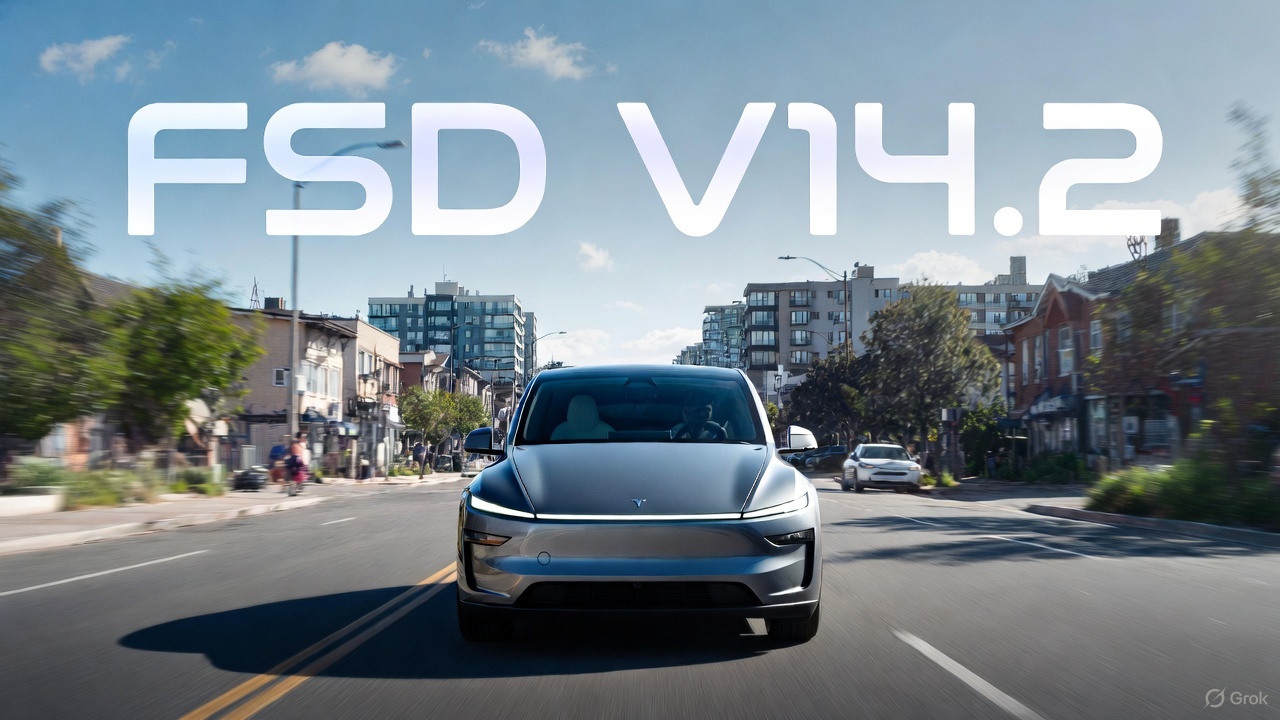
Tesla has begun pushing Full Self-Driving (Supervised) v14.2 to its initial batch of vehicles. The update was initially observed by Tesla owners and veteran FSD users on social media platform X on Friday.
So far, reports of the update have been shared by Model Y owners in California whose vehicles are equipped with the company’s AI4 hardware, though it would not be surprising if more Tesla owners across the country receive the update as well.
Based on the release notes of the update, key improvements in FSD V14.2 include a revamped neural network for better detection of emergency vehicles, obstacles, and human gestures, as well as options to select arrival spots.
It would likely only be a matter of time before FSD V14.2 videos are posted and shared on social media.
Following are the release notes of FSD (Supervised) V14.2, as shared on X by longtime FSD tester Whole Mars Catalog.

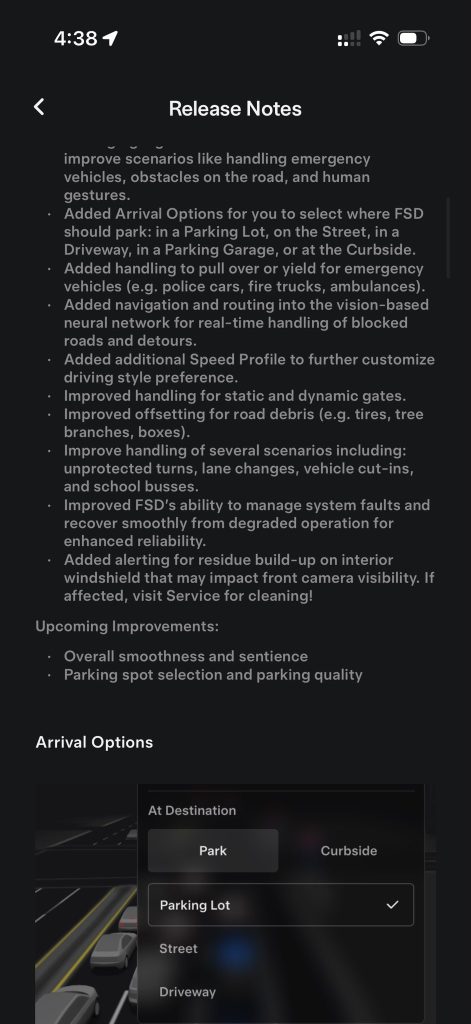
Release Notes
2025.38.9.5
Currently Installed
FSD (Supervised) v14.2
Full Self-Driving (Supervised) v14.2 includes:
- Upgraded the neural network vision encoder, leveraging higher resolution features to further improve scenarios like handling emergency vehicles, obstacles on the road, and human gestures.
- Added Arrival Options for you to select where FSD should park: in a Parking Lot, on the Street, in a Driveway, in a Parking Garage, or at the Curbside.
- Added handling to pull over or yield for emergency vehicles (e.g. police cars, fire trucks, ambulances.
- Added navigation and routing into the vision-based neural network for real-time handling of blocked roads and detours.
- Added additional Speed Profile to further customize driving style preference.
- Improved handling for static and dynamic gates.
- Improved offsetting for road debris (e.g. tires, tree branches, boxes).
- Improve handling of several scenarios including: unprotected turns, lane changes, vehicle cut-ins, and school busses.
- Improved FSD’s ability to manage system faults and improve scenarios like handling emergency vehicles, obstacles on the road, and human gestures.
- Added Arrival Options for you to select where FSD should park: in a Parking Lot, on the Street, in a Driveway, in a Parking Garage, or at the Curbside.
- Added handling to pull over or yield for emergency vehicles (e.g. police cars, fire trucks, ambulances).
- Added navigation and routing into the vision-based neural network for real-time handling of blocked roads and detours.
- Added additional Speed Profile to further customize driving style preference.
- Improved handling for static and dynamic gates.
- Improved offsetting for road debris (e.g. tires, tree branches, boxes).
- Improve handling of several scenarios, including unprotected turns, lane changes, vehicle cut-ins, and school buses.
- Improved FSD’s ability to manage system faults and recover smoothly from degraded operation for enhanced reliability.
- Added alerting for residue build-up on interior windshield that may impact front camera visibility. If affected, visit Service for cleaning!
Upcoming Improvements:
- Overall smoothness and sentience
- Parking spot selection and parking quality
